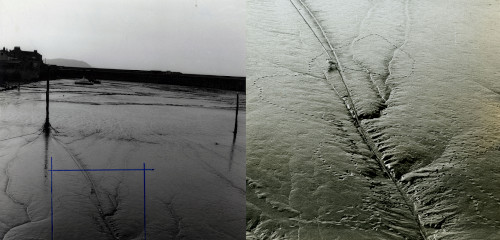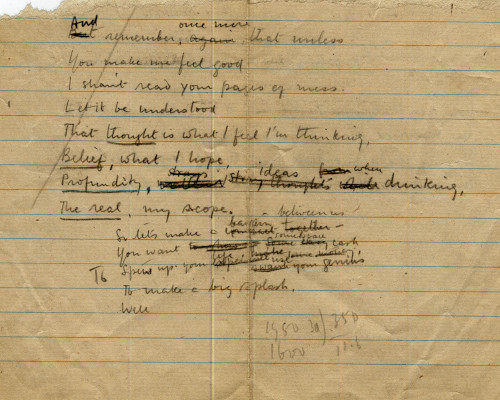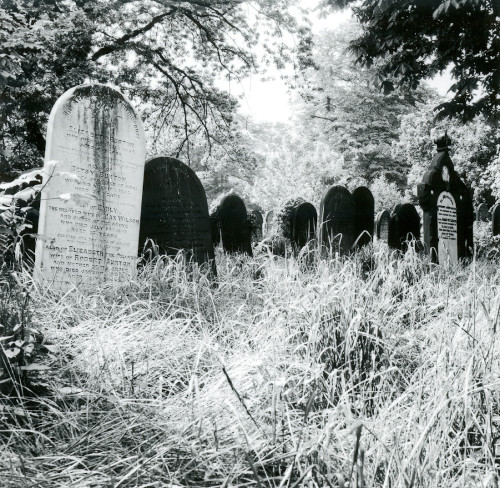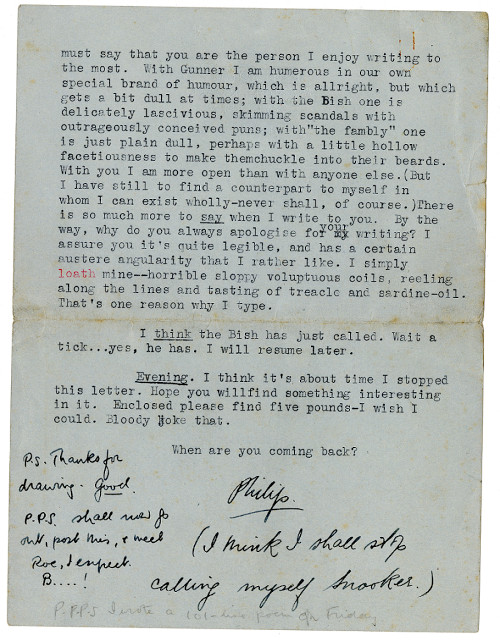Archives Hub feature for August 2022
Preserving a literary legacy…
‘I feel the only thing you can do about life is to preserve it, by art if you’re an artist, by children if you’re not’ (PAL, letter to Monica Jones)

The 9th of August 2022 marks the centenary of the birth of poet and librarian Philip Arthur Larkin.
His approach to life as represented in the above quote will resonate with anyone involved in archival work and research. It speaks to the core function of the archivist in preserving the surviving evidence of past thoughts, beliefs and events.
Although not born in Hull, Larkin was intimately connected with the city. Appointed to the post of Librarian at the University of Hull in March 1955, he spent half of his life in the area, living first in Cottingham, then in Hull’s Pearson Park, and finally in the well-to-do area of Newland Park near the University. Some of his most famous works were inspired by the experience of living in, travelling from and returning to the city. During his time at the University, he guided the library through a period of significant development, helping to transform it from a small operation in a series of makeshift spaces, to a purpose built and sector-leading academic library. Through his collaboration with academic colleagues, he promoted the growth of Hull University Archives from a small selection of manuscripts to an internationally significant repository for archive collections. So, it is fitting that his surviving archive is held at Hull as part of the University Archives.
Creative process of a poet…
‘[T]o construct a verbal device that would preserve an experience indefinitely by reproducing it in whoever read the poem’ (PAL, definition of the purpose of a poet, from Required Reading)
One of the most important of the Larkin related collections held at Hull is his personal archive which contains, amongst other things, his manuscript poetry workbooks.
Written in pencil, they contain manuscript drafts of poems written by Larkin, and provide evidence that he drafted and redrafted individual poems over several days or weeks, even returning to them months later. The pages sometimes feature small doodles or comments, giving us an insight into his feelings and state of mind in a given moment. Thus, the workbooks are a vital and unique record of Larkin’s creative process.
Capturing a view on life…
‘I feel the only thing you can do about life is to preserve it, by art if you’re an artist, by children if you’re not’ (PAL, letter to Monica Jones)
Aside from writing poetry, Larkin was a keen and skilled amateur photographer and the evidence is preserved in his photographic archive [RefNo. U DLV]. Having shown an interest in photography from a young age, Larkin was given a camera to use by his father, a Houghton-Butcher Ensign Carbine No.5. In a letter dated 1947, addressed to a childhood friend, he notes that he has spent a large amount of money on a camera of his own, believed to be a Purma Special. From this point there was no looking back, and later on he became known for his use of a professional quality Rolleiflex camera with timers, lenses and filters.

His approach to photography seems akin to that of his writing. His photographs skilfully capture the experience of everyday life according to fundamental principles of photographic composition. His subjects regularly include self-portraits, rural landscapes, church yards, and the friends, family and women in his life. His surviving photographs often show evidence that he marked up prints for enlargement to create a better composition.
Communication is key…
‘Man hands on misery to man. It deepens like a coastal shelf. Get out as early as you can, And don’t have any kids yourself’ (PAL, This be the verse)
In an age of emails, texts and social media, we perhaps forget how important letter writing was to communication in the mid-20th century. Larkin was a prolific letter writer, maintaining contact with friends, acquaintances, and family on a regular basis. There are many collections of his correspondence at Hull.
Highlights include letters sent to Monica Jones, his life-long partner [RefNo. U DX341], which reveal their close and frank relationship, along with aspects of Larkin’s character and life views. Another highlight is the correspondence between Larkin and his childhood friend James Sutton [U DP174 and U DP182]. The two friends discuss home life, friends, jazz music, and their current creative endeavours, which provides opportunity to explore Larkin’s formative years at home, school and university.
Further information…
In this centenary year we’ve been busy working to enhance access to the Larkin collections, improving catalogue descriptions, producing a new source guide and creating an online exhibition.
To access the source guide: https://libguides.hull.ac.uk/archives-at-hhc/published-guides
To explore the online exhibition: https://libguides.hull.ac.uk/larkin100/home
Claire Weatherall, Archivist
Hull University Archives
Related
Collections at Hull University Archives relating to Philip Larkin – letters, papers and more
Browse all Hull University Archives descriptions on the Archives Hub
Previous features on Hull University Archives
For those in peril on the sea – Seamen’s Missions archives at Hull History Centre (2019)
Papers of the Association of Chief Police Officers – the National Reporting Centre (2016)
Liberty, Parity and Justice at the Hull History Centre (2010)
All images copyright Hull University Archives. Reproduced with the kind permission of the copyright holders.





